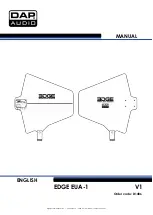
- 2 -
Theory of Operation
When an antenna is shortened from its natural resonant length, the feedpoint becomes capacitive.
To offset the additional capacitance, it is common to add inductance in the form of a loading coil to
restore the resonance. However, the additional inductor increases the resistance, which increases the
loss of the antenna. Hot Rodz solve this problem by using a capacity hat - a series of horizontal rods
that counters the effects of shortened vertical antennas.
A Capacity Hat Increases Antenna Efficiency
A capacity hat can be thought of as an extension of the Marconi antenna design that adds horizontal
elements to the design of an otherwise vertical antenna. The currents in Hot Rodz horizontal
elements offset one another and preserve the vertical polarization of the radiated wave.
Table 1
illustrates the real radiation resistance of a 6-foot mobile whip. There is a lot of confusion
about radiation resistance, but one definition is "
the resistive component of an antenna feedpoint
impedance caused by radiation from an antenna
". Mathematically, radiation resistance is the total
electromotive power divided by the square of the net current causing the radiation. In general, the
greater the radiation resistance, the more efficient the antenna.
Radiation Resistance of
6-Foot Mobile Whips
Frequency
Radiation Resistance
1.8 MHz
0.05 Ω
3.5 MHz
0.17 Ω
5.0 MHz
0.35 Ω
7.0 MHz
0.69 Ω
10 MHz
1.42 Ω
14 MHz
2.77 Ω
18 MHz
4
.59 Ω
21 MHz
6.24 Ω
24 MHz
8.15 Ω
28 MHz
11.1 Ω
The radiation resistance increases dramatically as
the frequency increases
Table 1 - Radiation Resistance of 6-Foot Mobile Whips
For instance, a 72-inch, 20 Meter whip antenna with a SWR of 1:1 has a feedpoint impedance of
50 Ω. However,
Table 1
shows the true radiation resistance of the antenna is somewhere near 3 Ω,
which means the loss in the system is 47 Ω (50 Ω - 3 Ω) and the radiation efficiency is 6%
(3Ω / 50 Ω). Therefore if an operator uses a 100-watt transmitter in the car, 94 watts are used to heat
the air and only 6 watts remain for communication. The loading coil and ground system generate a
loss of 94 watts; but if we remove the loss from the loading coil, then the base impedance drops by
the amount of the loss in the coil.






























